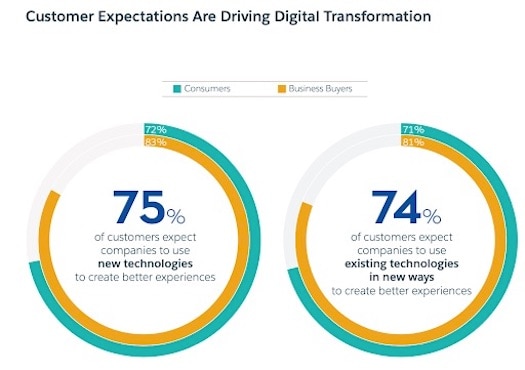In a post-pandemic, digital-first world, B2B organizations need to accelerate their digital commerce strategy. After all, with declines in face-to-face selling, B2B commerce helps buyers get products on store shelves faster, and lowers the cost to serve. According to Forrester, companies selling online with B2B commerce save $12 per order on average.
But how do you move online fast — and comprehensively — to get those benefits? These three proven steps can help you launch a B2B commerce storefront quickly.
1. Align objectives to new customer needs
Eighty-three percent of business buyers expect companies to use new technologies to create better experiences. The first step is to align your team around what you want to achieve. In other words, what are the biggest pain points to tackle first?

For example, the sales team at 83-year-old manufacturing company Chambers Gasket was spending too much time manually entering orders, as it required a lot of back-and-forth with customers — taking the same amount of time to enter large orders as small ones. The company decided to use B2B commerce, so sales won’t need to input orders, and instead can spend their time quoting and finding new, larger business opportunities.
Once you’ve identified your goal, perform both a “business as usual” audit and a separate review of the past two months. How have your sales reps engaged customers during this time? What has been successful? How can you yield the most ROI, build customer loyalty, or drive engagement?
2. Start small and use incentives
Many companies have the most success when they start small by focusing on one geography or business unit. A simpler or smaller division for a pilot allows for testing and optimization. For example, one leading consumer goods company started its B2B commerce site in Brazil. The company will apply those learnings to successfully expand into other regions.
Consider these other best practices:
- Start with a division that has a reliable supply chain. It’s not a good buying experience if a company’s first ecommerce site is mired with products that are out of stock.
- Focus on simplicity. Amid economic uncertainty, getting to market fast is most important. Companies today can use Salesforce’s Quick Start Commerce for B2B to get live with reordering and customer-specific catalogs in as little as two weeks.
- Incentivize implementation partners to use out-of-the-box features. It’s tempting to build a feature from scratch, but start with what already exists on your commerce platform. And make sure your implementation partners are incentivized to use your existing tools and capabilities, so they don’t bill for creating something that could have been done out-of-the-box. One big thing to remember is that until you get actual results and measurements around features adoption and real customer feedback, many features companies think they need in ecommerce may turn out to be less important to actual customers.
3. Track KPIs but don’t ignore qualitative insights
Measure success beyond your typical vanity metrics. Speed and agility are key, so set a goal for speed to launch your storefront.
- Coming in under budget is also a win. Make sure to track spending as you go, to ensure there aren’t any budgetary surprises.
- Think about the opportunity costs. What other resources are you now saving? For example, by eliminating data entry and manual tasks by its sales team, Chambers Gasket can now put more focus on growth.
- Lastly, measure online orders and total customer service requests. After Land O’ Lakes launched their Purina ecommerce storefront, they saw a 20% increase in online orders and a 10% decrease in service requests.
Setting up a B2B storefront is easier and faster than you may think. Get online in as few as two weeks with the Salesforce B2B Commerce Quick Start. And hear more about how to get online fast in our digital event Up Next in Commerce.





![[Illustration] An AI agent with people in bubbles representing different customer service jobs](https://www.salesforce.com/blog/wp-content/uploads/sites/2/2025/01/jobs-AI-will-create-1500x844_60k-1.jpg?w=128&h=96&crop=1&quality=75)






















